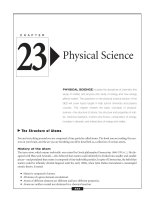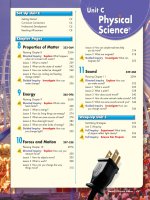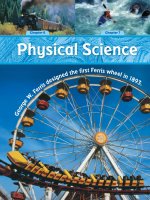4 16 using simple machines (physical science)
Bạn đang xem bản rút gọn của tài liệu. Xem và tải ngay bản đầy đủ của tài liệu tại đây (3.05 MB, 10 trang )
Genre
Nonfiction
Comprehension Skill
Summarize
Text Features
•
•
•
•
Captions
Labels
Diagrams
Glossary
Science Content
Simple Machines
Scott Foresman Science 4.16
ISBN 0-328-13905-X
ì<(sk$m)=bdjafh< +^-Ä-U-Ä-U
Vocabulary
effort
fulcrum
inclined plane
lever
load
pulley
screw
wedge
wheel and axle
What did you learn?
1. How is a screw a kind of inclined plane?
2. How could you use a simple machine to
split a log into two pieces?
3. If a heavy truck was to be lifted onto a
railroad car, how could it be done?
4.
The position
of
by Donna
Watson
a lever’s fulcrum, load, and effort can
change. Describe on your own paper
how the different kinds of levers work.
Use details from the book to support
your answer.
5.
Picture Credits
Every effort has been made to secure permission and provide appropriate credit for photographic material.
The publisher deeply regrets any omission and pledges to correct errors called to its attention in subsequent editions.
Photo locators denoted as follows: Top (T), Center (C), Bottom (B), Left (L), Right (R), Background (Bkgd).
2 John and Eliza Forder/Getty Images; 6 Michael Kim/Corbis; 8 (BL) Vince Streano/Corbis; 9 Ian Cartwright/LGPL/Alamy
Images; 11 Andre Jenny/Alamy Images; 13 Winston Luzier/Alamy Images.
Scott Foresman/Dorling Kindersley would also like to thank: 13 (BR) Stephen Oliver/DK Images..
Unless otherwise acknowledged, all photographs are the copyright © of Dorling Kindersley, a division of Pearson.
ISBN: 0-328-13905-X
Copyright © Pearson Education, Inc. All Rights Reserved. Printed in the United States of America.
This publication is protected by Copyright, and permission should be obtained from the publisher prior to any
prohibited reproduction, storage in a retrieval system, or transmission in any form by any means, electronic,
mechanical, photocopying, recording, or likewise. For information regarding permission(s), write to
Permissions Department, Scott Foresman, 1900 East Lake Avenue, Glenview, Illinois 60025.
3 4 5 6 7 8 9 10 V010 13 12 11 10 09 08 07 06 05
Summarize If you try to push a huge
boulder, you might get very tired without
actually doing any work. Summarize how
this could happen.
Machines
Science has a special definition for work. Work
happens any time force is used to move something or
make a change. If you lived on a farm, you might have to
help get a fifty-pound bale of hay into the barn. Picking
that up would be too heavy! Pushing or pulling with all
your strength probably wouldn’t budge the hay either.
No matter how tired you might be from trying, if the
hay did not move, you did not do any work.
Machines make work easier. If an object is heavy,
you must use a lot of force to move it. Some simple
machines help you do work while using less force.
It would be easier to move that bale of hay if you
had some kind of simple machine to help you.
Some simple machines can change the direction of
the force you use. With a simple machine, pushing or
pulling in one direction can cause work to get done in
a different direction.
Many simple machines are made of only one or two
parts. But they need only these few parts to make work
easier. The most common simple machines are the lever,
the pulley, the inclined plane, the wheel and axle, the
wedge, and the screw.
Doing some jobs by hand is difficult.
Machines make work easier.
2
3
A screwdriver can
be used as a lever.
It can help you
open a can of paint.
The Lever
A lever is a bar that rests on a support. The support
is called the fulcrum. You can use a lever to help you lift
an object. The load is the object you are lifting. Effort is
the push or pull you apply to the lever to make the
load move.
A lever does not make you stronger. It also does not
make the force needed to lift the object less. A lever
adds to your force. This way you can use less force to
move a load. It also changes the direction of the force.
Changing the location of the fulcrum changes the
amount of force you need.
Have you ever used a
screwdriver to pry open the top
of a paint can? The screwdriver
can be a lever. The fulcrum is the
effort
edge of the paint can. The load is
the top of the can. The effort is
your hand on the handle of the
screwdriver. The lever pushes
against the fulcrum and makes
lifting the lid easier.
One group of levers has its
fulcrum between the effort and
the load. The load and effort on
a seesaw change places. The person
moving toward the ground is the
effort. The person being lifted is
wheelbarrow
the load. Then this reverses.
Another group of levers has
the load between the effort
and the fulcrum. The wheel at
the end of a wheelbarrow is the
chopsticks
fulcrum. You supply the effort by
lifting the handles. A third group
of levers has the effort between the
fulcrum and the load. The effort for
a pair of chopsticks is where you
hold them. The fulcrum is where the
chopsticks are touching. The load is
the walnut.
seesaw
load
fulcrum
4
5
The Wheel and Axle
It’s probably easy for you to
picture a wheel and axle. A wheel
and axle is a kind of lever that
moves or turns objects. The axle is
a rod that goes through the center
of the wheel. Faucets can have a
wheel and axle. Suppose you tried to
Faucets use a
turn on a faucet with only a thin metal wheel and axle to
rod to hold on to and rotate. You
turn on and off.
wouldn’t have to turn it very far, but it
would be very hard to turn. Now suppose a large knob
was attached to the thin metal rod. Your hand would
have to travel a longer distance as it turned the large
knob, but you wouldn’t have to push as hard. The knob
is the wheel, and the thin rod is the axle.
It is easy to see the wheel
and axle on racing cars.
6
You might not think so, but a wrench is a kind of
wheel and axle. A wrench is used to tighten objects such
as bolts. The bolt is the axle. The wrench is the wheel.
The wrench turns around in a circle, which is the same
path that a wheel travels in. You could turn the bolt
without using a wrench, but you would have to use
more force. Using the wrench
to turn the bolt allows you to
do the same amount of work
while using less force. But
the distance that you have
to turn the wrench is greater
than the distance that you
would turn the bolt.
We use wrenches
to tighten bolts.
7
The Pulley
pulleys
A pulley is a wheel with a rope,
effort
wire, or chain around it. It changes the
direction of force. A pulley allows you
to raise something by pulling on a rope
instead of pushing the object from
below. What can you pull that uses a
pulley? Every time you pull the cord
to raise the blinds on your bedroom
window, you’re using a pulley. Think of
how the cord slides over
load
a wheel as it moves the
blinds. As you pull
down on the cord, the blinds are raised
up. Some people have a clothesline that
they can pull to bring clothes closer to
them. If you examine the clothesline,
you’ll see that it slides over a kind of
wheel to form a pulley.
A flagpole also makes use of a
pulley. A flag is attached to a rope.
The rope wraps around a wheel,
making a pulley. Pulling on the
rope can raise or lower the flag.
8
Sometimes more than one pulley is used to
pull an object. Two or more pulleys make up a
system of compound pulleys. This system allows
you to do work using less
force. A system of
compound pulleys may
have one pulley that is
fixed in place. Then the
system is known as a
block and tackle. The
more pulleys you add to
a system, the less effort
you need to lift a load.
Cranes use pulleys
to lift very heavy
objects, such as
this boat.
9
Machines Working
Together
The Inclined Plane
Suppose you want to move a refrigerator up the
front stairs into your house. What would be the easiest
way to do that? The refrigerator would be too heavy to
lift up the stairs. What else could you do? You could use
a ramp. You could put a strong piece of wood over the
steps so you could slide the refrigerator into the house.
That would make your work easier.
A ramp is a simple machine called an inclined plane.
You are still using the same amount of force when you
use an inclined plane as you would if you lifted the
object straight up. But you apply less force over a greater
distance when you move an object
using an inclined plane. This makes
the job easier.
What affects force?
Objects can move up or down an inclined plane.
Friction affects how these objects move. Friction is a force
that makes it harder for one substance to move against
another. It slows down movement along an inclined plane.
If a box at the top of an inclined plane stays in place, then
the force of friction has balanced the force of gravity.
What if there are wheels on the bottom of the box? Then
the box will most likely roll down the inclined plane. The
wheels take away most of the force of friction.
A mountain road is an example of an inclined plane.
Powering a car straight up a mountain would require a
great deal of effort from the car’s engine. Providing
power for the car to travel along a road that zig zags back
and forth up the side of the mountain requires less
effort. The car uses less force over a
greater distance.
Mountain roads are often
inclined planes. Cars travel
farther, but with less effort.
It is easier to push
something up an inclined
plane than to lift it.
10
11
The Wedge
A wedge is a special inclined plane.
You can think of a wedge as two inclined
planes put together. A wedge has one wide
end and one narrow end. The narrow end
can be put between two objects to push or
hold them apart. The narrow end moves
forward when a force acts on the wide end.
Suppose two ice cubes are frozen
together. A wedge can be used to separate
them. You can put the narrow end of the
wedge up against the ice. Then you can
chopping wood
tap on the wide end of the wedge, driving
with a wedge
the narrow end deeper into the ice. The
shape of the wedge changes the force that moves forward
into a force that moves outward. This pushes the two ice
cubes apart. A wedge can also split a piece of wood in
the same way.
The Screw
A screw is a kind of inclined
plane. It is a rod that has an inclined
plane wrapped around it. The inclined
plane forms ridges that are called
threads. Screws have many uses. They
can join things together. They can lift
things. You must turn a screw many
times using a screwdriver.
12
The screw-on lid on
this bottle keeps it
tightly covered.
You see screws in many places.
A light bulb has a screw at its base
to fasten into a lamp. Without this,
the bulb would fall right out of the
lamp. Many jars have lids that can
be screwed on. Have you wondered
how you might keep jars covered if
there were no screw-on lids?
force
motion
The base of this light
bulb is a screw.
13
Complex Machines
Simple machines can be used together
to help us get even more work done.
When one or more simple machines
combine to do a job, they are
known as complex machines.
A pair of
You probably use complex
scissors is
machines every day. Anything
a complex
machine.
that has a sharp edge, such as a
pair of scissors, is a wedge.
On a pair of scissors, the two blades that meet are each
wedges, but they are also levers. They are joined at a
fulcrum. That’s two different machines in a regular pair
of scissors.
A bicycle is a complex machine. Its two wheels are
wheels and axles. A chain connects the pedals with the
axle of the back wheel. The chain wraps around
a metal wheel, making the whole thing a
pulley. The chain helps make the tires
move when you do the work of
moving the pedals.
A bicycle also has gears.
A gear is a wheel with points.
These points are called teeth.
Gears are often used in pairs.
Wherever you are—whether it is at school
or at home—look for machines at work. You can
easily spot some of the six simple machines—the
lever, wheel and axle, pulley, inclined plane, screw,
and wedge. Now you can also look at other items,
such as workbench tools or kitchen tools, and figure
out which simple machines might be working
together as a complex machine!
A bicycle is a complex machine.
You provide the effort
by pushing the pedals.
wheel and axle
chain (pulley)
14
15
Vocabulary
Glossary
effort
fulcrum
effort
inclined plane
lever
load
fulcrum
pulley
screw
wedge plane
inclined
wheel and axle
a push or pull that makes a load
move in some way
the base on which a lever and
a load are supported
a simple machine also known
as a ramp
lever
a simple machine made of a bar
with a fulcrum
load
an object to lift or move
pulley
a simple machine made of a wheel
with a rope, wire, chain, or cord
around it
Picture Credits
Every effort has been made to secure permission and provide appropriate credit for photographic material.
The publisher deeply regrets any omission and pledges to correct errors called to its attention in subsequent editions.
screw
a simple machine made of an inclined
2 John and Eliza Forder/Getty Images; 6plane
Michael Kim/Corbis;
8 (BL) Vince
Streano/Corbis;
9 Ian Cartwright/LGPL/Alamy
wrapped
around
a rod
Photo locators denoted as follows: Top (T), Center (C), Bottom (B), Left (L), Right (R), Background (Bkgd).
Images; 11 Andre Jenny/Alamy Images; 13 Winston Luzier/Alamy Images.
Scott Foresman/Dorling Kindersley would also like to thank: 13 (BR) Stephen Oliver/DK Images..
wedge
a simple machine made of two
inclined planes put together
Unless otherwise acknowledged, all photographs are the copyright © of Dorling Kindersley, a division of Pearson.
wheel and axle
a simple machine made of a lever
Copyright © Pearson Education, Inc. Allthat
Rights Reserved.
Printed
United States
of America.
moves
orin the
turns
objects
This publication is protected by Copyright, and permission should be obtained from the publisher prior to any
ISBN: 0-328-13905-X
prohibited reproduction, storage in a retrieval system, or transmission in any form by any means, electronic,
mechanical, photocopying, recording, or likewise. For information regarding permission(s), write to
Permissions Department, Scott Foresman, 1900 East Lake Avenue, Glenview, Illinois 60025.
3 4 5 6 7 8 9 10 V010 13 12 11 10 09 08 07 06 05
16
What did you learn?
1. How is a screw a kind of inclined plane?
2. How could you use a simple machine to
split a log into two pieces?
3. If a heavy truck was to be lifted onto a
railroad car, how could it be done?
4.
The position of
a lever’s fulcrum, load, and effort can
change. Describe on your own paper
how the different kinds of levers work.
Use details from the book to support
your answer.
5.
Summarize If you try to push a huge
boulder, you might get very tired without
actually doing any work. Summarize how
this could happen.









